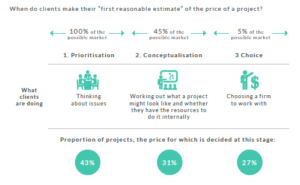Anyone involved in the marketing of consulting and other professional services will be familiar with the funnel, which analyses how well a firm is performing from overall awareness (the top of the funnel) to final choice (the bottom). But looking at the purchase process through clients’ eyes reveals other, equally important lessons.
The point at which a consulting firm’s funnel starts—a client’s overall awareness of specific firms—is where the client funnel finishes. That’s because the story from a client’s point of view starts much earlier, with internal discussions about the organisation’s goals. Here, a huge number of different items are fighting for their place at the top of the corporate to-do list, each one uppermost in the minds of some CxOs. The debate about which of these competing priorities should be allocated investment, not just in financial terms but in management time and organisational effort, is intense. Once it’s over, the next challenge is to work out how a particular objective is going to be delivered (we call this phase “conceptualisation”). What resources will it require? Are these resources available in-house? Finally, only once agreement is reached on these issues, can a client turn to the external market to look for consulting and other support.
We estimate that only one in 20 possible consulting projects make it through to this last stage: Some never get on the to-do list in the first place; others can be done by a client’s own team. This means that the point where the consulting marketing funnel intersects with the client’s purchase funnel represents only 5% of the total potential market and that consulting firms, if they want to win more work at this point, need to invest more in understanding how clients prioritise and conceptualise.
Nothing illustrates the importance of doing this more than pricing, as a report we published earlier this year demonstrates. In Pricing: Your biggest barrier to change? we asked clients to walk us through their purchase process in terms of the way it impacted the price they ended up paying.
Generally, when we ask about a range of attributes that influence clients’ decisions about which firms to hire, price is usually a third or three-quarters of the way down the list. Yet, if we ask the same question of consulting firms, price is usually seen to be near the top—and part of the motivation behind writing this report was to understand who’s right. It turns out that both are, and that the influence of price starts very early indeed. Around three-quarters of clients have come up with their “first reasonable estimate” of the price of a consulting project before they issue an RFP and begin the process of deciding which firm to hire. In fact, 43% have come up with that first reasonable estimate when they’re prioritising what to do and before they’ve even got to the point of considering whether they have sufficient resources in-house to do the work.

Key to influencing this part of the purchase process is thought leadership. The importance of thought leadership has increased over the last decade, partly in response to fake news (clients think the material produced by consulting and other professional services firms is reliable and robust) and more recently because of the pandemic, when clients needed new sources of data to deal with unprecedented challenges. But, our recent research reveals, 93% of clients think it also has an impact on the price they end up paying for consulting work; 52% say it has a significant impact. That makes sense: If a client has read high-quality, trustworthy material that makes a compelling argument for a particular course of action and provides evidence of the economic value that will result from it, it’s more likely that clients will be willing to invest more money in the initiative. If that case is also made by a top-flight strategy firm, clients may—unconsciously at least—recalibrate how much they’re prepared to pay.
Consulting firms shouldn’t have tunnel vision about their funnel.